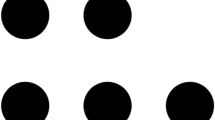Abstract
Three issues about students’ reasoning, proving and understanding proof in number patterns are investigated in this paper. The first is to elaborate the features of junior high students’ reasoning on linear and quadratic number patterns. The second is to study the relationships between 9th graders’ justification of mathematical statements about number patterns and their understanding of proof and disproof. The third is to evaluate how reasoning on number patterns is related to constructing proofs. Students in this study were nationally sampled by means of two stages. Some new findings which have not been discovered in some past researches are reported here. These findings include (1) checking geometric number patterns appears to have different positions between the tasks of the linear and the quadratic expressions; (2) proof with the algebraic mode is easy to know but hard to do; (3) disproof with only one counterexample is hard to know but easy to do; (4) arguments with empirical mode or specific symbols were hard for students to validate but very convincing for them; and (5) reasoning on number patterns is supportive for proving in number patterns, and reasoning on number patterns and proof in algebra should be designed as complementary activities for developing algebraic thinking.
Similar content being viewed by others
References
Balacheff, N. (1991). Treatment of refutations: Aspects of the complexities of a constructivist approach to mathematics learning. In Glaserfeld (Ed.), Radical constructivism in mathematics education. The Netherlands: Kluwer Academic Publishers.
Bednarz, N., Kieran, C. & Lee, L. (1996). Approaches to algebra. Dordrecht: Kluwer Academic Publishers.
Bishop, J. (2000). Linear geometric number patterns: Middle school students’ strategies. Mathematical Education Research Journal, 12(2), 107–126.
Boero, P., Garuti, R. & Mariotti, M.A. (1996). Some dynamic mental processes underlying producing and proving conjectures. PME 20(2), 121–128.
Campbell (2002). What is number theory? PME 26(1), 208–212.
Chazan, D. (1993). High school geometry students’ justification for their views of empirical evidence and mathematical proof. Educational Studies in Mathematics, 24(4), 359–387.
Curriculum Corporation for the Australian Educational Council (1990). National statement on mathematics for Australian schools. Victoria: Curriculum Corporation.
Galbraith, P.L. (1981). Aspects of proving: A clinical investigation. Educational Studies in Mathematics, 12, 1–28.
Gravemeijer, K. & Stephan, M. (2002). Emergent models as an instructional design heuristic. In Gravemeijer, Lehrer, Oers & Verschaffel (Eds.), Symbolizing, modeling and tool use in mathematics education. The Netherlands: Kluwer Academic Publishers.
Hanna, G. & Jahnke, H.N. (Eds.) (1993). Aspects of proof (special issue). Educational Studies in Mathematics, 24(4).
Harel, G. & Sowder, L. (1998). Students’ proof schemes: Results from exploratory studies. In A.H. Schoenfeld, J. Kaput & E. Dubinsky (Eds.), Research in collegiate mathematics education 3 (pp. 234–283). Mathematical Association of America.
Healy, L. & Hoyles, C. (1998). Justifying and proving in school mathematics. Technical report, London, Institute of Education, University of London.
Healy, L. & Hoyles, C. (2000). A study of proof conception in algebra. Journal for Research in Education, 31(4), 396–428.
Kuchemann, D. & Hoyles, C. (2001). Investigating factors that influence students’ mathematical reasoning. PME 25(3), 85–92.
MacGregor, M. & Stacey, K. (1995). The effect of different approaches to algebra on students’ perceptions of functional relationships. Mathematical Education Research Journal, 7(1), 69–85.
Mason, J. (1985). Thinking mathematically. Wokingham: Addison-Wesley.
Moore, R. (1994). Making the transition to formal proof. Educational Studies in Mathematics, 27, 249–266.
National Council of Teachers of Mathematics (NCTM) (1989). Curriculum and evaluation standards for school mathematics. Reston, VA: National Council of Teachers of Mathematics.
National Council of Teachers of Mathematics (NCTM) (2000). Principles and standards for school mathematics. Reston, VA: National Council of Teachers of Mathematics.
Orton, A. (1999). Pattern in the teaching and learning of mathematics. London: Cassell Wellington House.
Radford, L. (2000). Signs and meaning in students’ emergent algebraic thinking: A semiotic analysis. Educational Studies in Mathematics, 42(3), 237–268.
Raman, M. (2003). Key ideas: What are they and how can they help us understand how people view proof? Educational Studies in Mathematics, 52, 319–325.
Sfard, A. (1991). On the dual nature of mathematical conceptions: Reflections on processes and objects as different sides of the same coin. Educational Studies in Mathematics, 22, 1–36.
Simon, M. (1996). Beyond inductive and deductive reasoning. Educational Studies in Mathematics, 30, 197–210.
Stacey, K. (1989). Finding and using patterns in linear generalizing problems. Educational Studies in Mathematics, 20, 147–164.
Taiwan Ministry of Education (2003). A draft plan of nine-year joint mathematics curriculum guidelines (in Chinese). Taiwan Ministry of Education.
Thompson, A.G. & Thompson, P.W. (1995). A cognitive perspective on the mathematical preparation of teachers: The case of algebra. In Lacampagne, Blair & Kaput (Eds.), The algebra initiative colloquium, Vol. 1 (pp. 95–116). Washington, DC: US Department of Education.
Zaslavsky, O. & Ron, G. (1998). Students’ understanding of the role of counter-examples. PME 22(4), 225–232.
Zazkis, P. & Liljedahl, P. (2002). Generalization of patterns: The tension between algebraic thinking and algebraic notation. Educational Studies in Mathematics, 49, 379–402.
Author information
Authors and Affiliations
Rights and permissions
About this article
Cite this article
Lin, FL., Yang, KL. & Chen, CY. The Features and Relationships of Reasoning, Proving and Understanding Proof in Number Patterns. Int J Sci Math Educ 2, 227–256 (2004). https://doi.org/10.1007/s10763-004-3413-z
Issue Date:
DOI: https://doi.org/10.1007/s10763-004-3413-z




